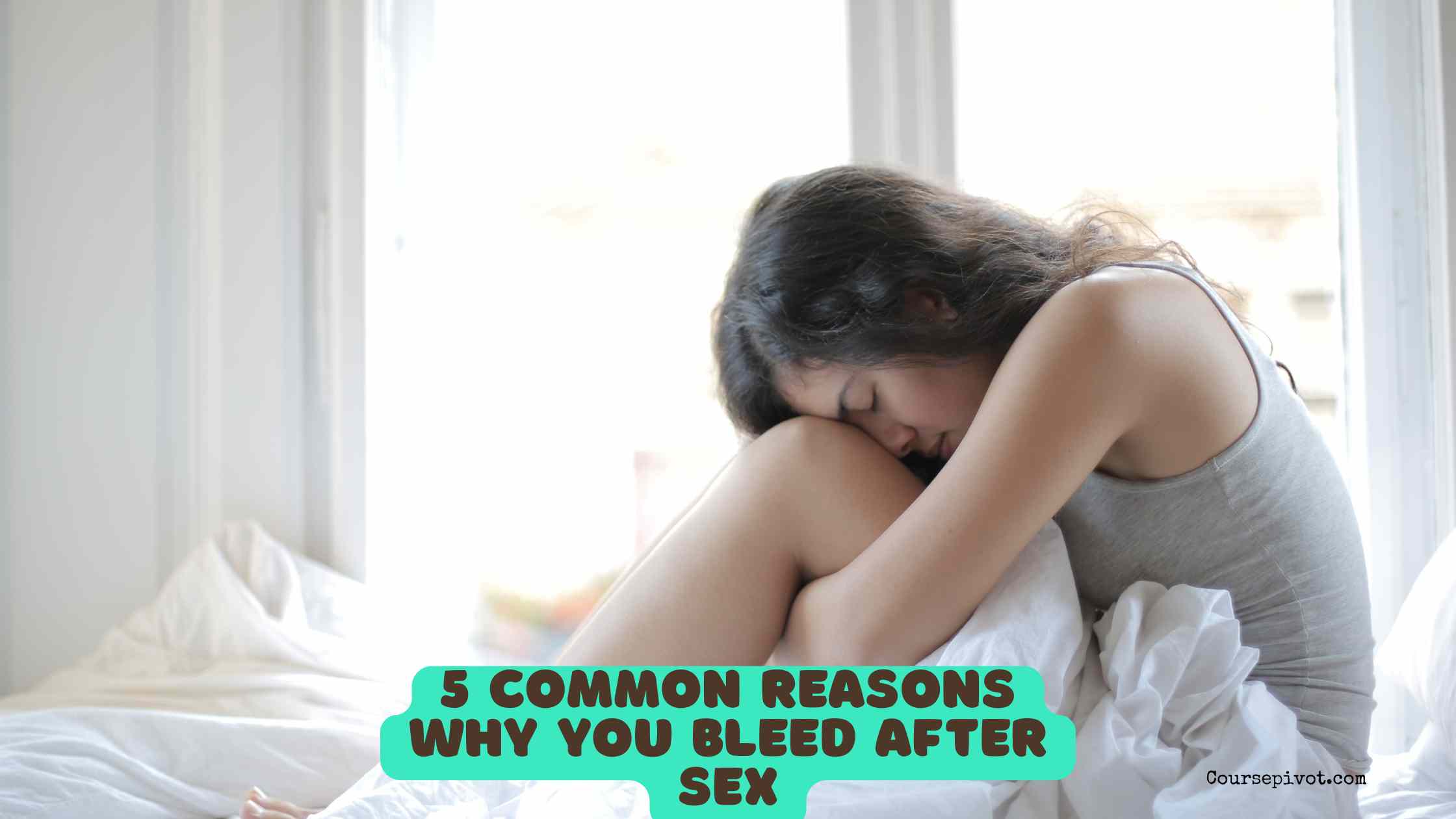
5 Common Reasons Why You’re Bleeding After Sex
Experiencing bleeding after sex, known as postcoital bleeding, can be alarming, but it’s often tied to benign causes. It affects up to 9% of women at some point, according to a 2023 study in the Journal of Women’s Health, and while usually harmless, it can occasionally signal a need for medical attention. For both men and women, understanding the underlying reasons can ease concerns and guide next steps.
Table of Contents
This blog explores 5 common reasons why I am bleeding after sex, backed by medical insights, with practical advice on when to seek help and how to address it.
The Basics of Postcoital Bleeding
Postcoital bleeding refers to vaginal or penile bleeding right after or within a day of sexual intercourse. It’s more common in women due to the anatomy of the reproductive tract, but men can experience it too. Causes range from physical irritation to medical conditions, with 60% of cases linked to minor issues like dryness, per the American College of Obstetricians and Gynecologists (ACOG). Persistent or heavy bleeding, however, warrants a doctor’s visit. Here are the top five reasons, with examples to clarify.
1. Vaginal or Penile Dryness and Friction
Insufficient lubrication during sex can cause friction, leading to microtears in the vaginal or penile tissue. This is the most common cause, affecting 30–40% of postcoital bleeding cases, per a 2024 Cleveland Clinic report. For women, dryness may occur due to hormonal changes (e.g., menopause, breastfeeding) or inadequate arousal. For men, rough intercourse or lack of lubrication can irritate the penile skin, especially if uncircumcised. Example: A woman in her 40s might notice spotting after rushed intercourse without enough foreplay.
Why It Matters: Dryness is easily treatable but can worsen if ignored, leading to discomfort or infection. About 20% of women over 50 report dryness-related bleeding, per ACOG.
2. Cervical or Vaginal Irritation
In women, the cervix (the lower part of the uterus) is sensitive and can bleed if irritated during deep penetration or vigorous sex. Conditions like cervical ectropion (where cervical cells grow outward, affecting 5–15% of women) or cervicitis (inflammation, often from infections) increase this risk. Cervical polyps, benign growths in 2–5% of women, can also bleed on contact. For example, a woman might notice light pink spotting after intercourse if a polyp is present.
Why It Matters: While often benign, cervical issues may signal infections (e.g., chlamydia, affecting 4% of young women) or, rarely, precancerous changes, per the NIH.
3. Infections or Sexually Transmitted Infections (STIs)
Infections like yeast infections, bacterial vaginosis, or STIs (e.g., chlamydia, gonorrhea) can inflame vaginal or penile tissue, causing bleeding after sex. STIs affect 1 in 5 sexually active adults in the U.S., per the CDC, with 30% of postcoital bleeding cases linked to infections. For men, urethritis (inflammation of the urethra) from STIs can cause blood in semen or urine post-sex. Example: A person might notice bleeding with itching or discharge, signaling a yeast infection.
Why It Matters: Untreated infections can lead to complications like pelvic inflammatory disease (10–15% of chlamydia cases in women). Testing and treatment are critical.
4. Menstruation or Hormonal Changes
For women, bleeding after sex may coincide with the start or end of a menstrual period, especially if cycles are irregular (affecting 14–25% of women, per Mayo Clinic). Hormonal fluctuations from birth control, menopause, or pregnancy can thin vaginal tissue, making it prone to tearing. For example, spotting after sex during the first trimester is common in 15–25% of pregnancies due to cervical sensitivity.
Why It Matters: Hormonal bleeding is usually harmless, but persistent spotting outside periods needs evaluation to rule out other causes.
5. Trauma or Medical Conditions
Physical trauma from rough sex, nonconsensual activity, or improper use of sex toys can cause tears, leading to bleeding. In rare cases, serious conditions like cervical or endometrial cancer (1% of cases) or prostate issues in men (e.g., prostatitis, affecting 8% of men) may cause postcoital bleeding. For instance, heavy bleeding with pain in a woman over 40 could signal a need for a Pap smear or biopsy.
Why It Matters: While trauma is often minor, bleeding with symptoms like pelvic pain or abnormal discharge requires urgent medical attention, as 1 in 3,000 cases may link to cancer, per ACOG.
When to See a Doctor
Most bleeding resolves on its own, but seek medical help if you experience:
- Heavy bleeding (soaking a pad in an hour).
- Persistent spotting (beyond 2–3 episodes).
- Pain, fever, or unusual discharge.
- Bleeding with irregular periods or after menopause.
About 10% of postcoital bleeding cases require treatment for infections or polyps, per Cleveland Clinic. Men should see a urologist if blood appears in semen or urine.
Practical Tips to Address and Prevent Bleeding
- Use Lubrication: Apply water-based lubricants (e.g., K-Y Jelly) to reduce friction; 80% of dryness cases improve, per ACOG.
- Practice Gentle Sex: Increase foreplay and communicate with partners to avoid irritation.
- Get Tested: Visit a clinic for STI or infection screening; free testing is available at Planned Parenthood.
- Monitor Cycles: Track periods with apps like Clue to distinguish hormonal bleeding.
- See a Doctor: Schedule a gynecologist or urologist visit for persistent issues; Pap smears detect 95% of cervical issues early.
- Maintain Hygiene: Avoid douches or harsh soaps, which irritate tissue in 20% of users.
Things to Avoid
Don’t ignore persistent bleeding—delaying care risks complications. Avoid unprotected sex if infections are suspected; condoms reduce STI risk by 70%. Don’t use petroleum-based lubricants with condoms—they degrade latex. Steer clear of self-diagnosing serious conditions; consult a professional.
Tailoring to Your Situation
Women in Menopause: Use vaginal moisturizers like Replens. Young Adults: Prioritize STI testing. Men: Check for urethritis if bleeding persists. Couples: Discuss comfort levels during sex. Adjust based on age and health for effective prevention.
Key Takeaways
Bleeding after sex is often caused by dryness (30–40% of cases), cervical irritation, infections/STIs, hormonal changes, or trauma/medical conditions. Affecting up to 9% of women and some men, it’s usually benign but requires attention if persistent or paired with pain. Use lubricants, get tested, and see a doctor for ongoing issues to catch rare serious causes (1% cancer-linked). By addressing triggers and seeking care, you can restore comfort and peace of mind. If you’re spotting after sex, what’s your next step to feel better?
Cite this article
You can copy and paste your preferred citation format below.
Martin, L. & Arquette, E.. (2025, October 3). 5 Common Reasons Why You’re Bleeding After Sex. Coursepivot.com. https://coursepivot.com/blog/5-common-reasons-why-youre-bleeding-after-sex/



